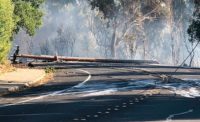After the latest distressing round of California wildfires and blackouts, more needs to be done to improve, not just rebuild, the aged power grid now recognized as causing some of the fires. Fixing the fragile system has been on the infrastructure to-do list for years. The rising Western wildfire threat is the newest problem to rise to the top. A system rebuild must avoid simply restoring it to status quo.
In our view, any upgrades must create “cornerstones” for a system that includes hardened infrastructure, buried lines and distributed generation. The hardening techniques are well known: raise seawalls, restore natural coastal protections, move generating plants or transmission and distribution lines, and expand tree-trimming. Using better materials, such as high-temperature, low-sag conductors—line sag led to the 2003 Northeast blackout—also helps.
Targeted line undergrounding, based on life-cycle costs, has been applied strategically, most notably by San Diego’s utility, which is converting 15 miles of overhead lines a year, and by Duke Energy in the eastern states it serves. Utility customers are usually all for undergrounding, which has been long studied. But there are trade-offs. When buried lines fail or sustain damage, it takes longer and costs more to detect faults and restore service.
The Western wildfire threat is the newest issue to rise to the top. A rebuild of the system must avoid simply restoring it to the status quo.
Most of the time, however, installation costs are the real crusher. A 2005 study of Florida’s investor-owned utilities estimated that undergrounding distribution lines and feeders would cost $95 billion and increase rates 80%. Nationally, Edison Electric Institute cost estimates vary, based on different voltages, to convert overhead to underground distribution lines—ranging from $158,000 to $1.9 million per mile, about evenly split between labor and materials.
Pacific Gas & Electric, the bankrupt utility whose lines are believed to have touched off several recent wildfires, has done some undergrounding conversions via a state public service commission rule that spells out whether ratepayers or developers pick up the costs. Per mile, PG&E reports, its cost to convert overhead to underground distribution lines is $3 million. New overhead lines cost only $800,000 per mile. PG&E faces added problems because it serves urban and rural parts of the state. Of 107,000 miles of distribution line, only 26,000 are underground.
In the long run, distributed generation makes much more sense. In the event of a disaster, power producers can be switched to local mode and disconnected from the grid, so they would not be affected by an outage. Also, a small local grid would be easier to maintain because it would not have long, high-voltage transmission lines running through areas with a lot of vegetation. The solutions to improve power infrastructure are known. We need practical leadership to change course in the midst of the emergencies created by the aged system we now have.




Post a comment to this article
Report Abusive Comment